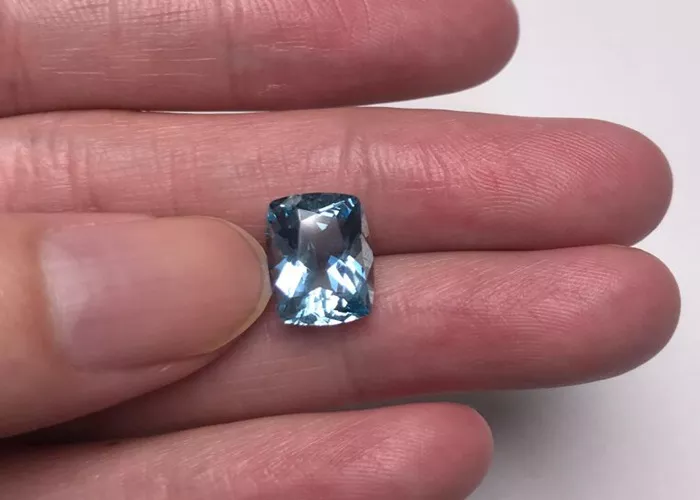Aquamarine, named after the Latin words for “water” and “sea,” has captivated jewelry lovers for centuries. This stunning blue gemstone belongs to the beryl mineral family, which also includes emerald and morganite. With a hardness of 7.5 to 8 on the Mohs scale, aquamarine is durable enough for everyday wear while offering exceptional brilliance. Its color palette ranges from the palest sky blue to deeper ocean blue-green hues, with the most prized specimens displaying a vibrant, medium-blue saturation without green undertones.
Understanding the 4Cs of Aquamarine Valuation
Like diamonds, aquamarines are evaluated based on four critical factors that determine their quality and price:
Color: The Most Important Value Factor
The finest aquamarines display a pure, intense blue reminiscent of tropical waters. Color grading considers three elements:
- Hue: The dominant color (blue vs. blue-green)
- Tone: The lightness or darkness (medium tones are most valuable)
- Saturation: The color’s intensity (strong saturation commands premium prices)
Clarity: Eye-Clean is the Standard
Most high-quality aquamarines are Type I gems, meaning they’re expected to be eye-clean (no visible inclusions). Common inclusions include:
- Liquid “fingerprint” inclusions
- Parallel tubes that create cat’s eye effects
- Hexagonal growth tubes
Cut: Maximizing the Gem’s Beauty
Skilled cutters must consider:
- Optimal proportions for light return
- Pleochroism (color variation from different angles)
- Weight retention from rough to finished gem
Carat Weight: Size vs. Price Considerations
While we focus on 1-carat stones, it’s important to note that aquamarine prices don’t increase linearly with size. Larger stones (5+ carats) of top quality can command disproportionately higher prices.
Geographic Origins and Their Impact on Value
Aquamarine deposits occur worldwide, but some locations produce notably superior gems:
Brazil: The Premier Source
- Minas Gerais region produces the finest blues
- Santa Maria de Itabira mine yields the coveted “Santa Maria” color
- Newer deposits in Pedra Azul producing excellent material
African Sources
- Mozambique: Bright blue stones with excellent clarity
- Nigeria: Slightly greener hues but large sizes available
- Madagascar: Unique pastel blues with high transparency
Other Notable Locations
- Pakistan’s high-altitude mines produce intense blues
- Russian aquamarines from the Ural Mountains
- Limited production from the United States (Colorado)
Current Market Prices for 1-Carat Aquamarines
Price ranges reflect mid-2024 market conditions:
Commercial Quality (20−100 per carat)
- Pale blue or noticeable green tint
- May have visible inclusions
- Often mass-produced cuts
Good Quality (100−300 per carat)
- Pleasant medium blue color
- Eye-clean to minor inclusions
- Decent cutting proportions
Fine Quality (300−800 per carat)
- Strong, saturated blue color
- Excellent clarity
- Precision cutting
Top Gem Quality (800−2,500+ per carat)
- Vivid “Santa Maria” blue
- Flawless to loupe-clean
- Ideal cut proportions
- May be unheated (natural color)
Treatment and Enhancement Considerations
Most aquamarines on the market undergo treatments:
Heat Treatment
- Permanently removes green/yellow components
- Industry-accepted when disclosed
- Can improve color by 20-50%
Irradiation
- Less common but sometimes used
- Creates deeper blue colors
- Should always be disclosed
Identifying Untreated Stones
- Command 30-100% premium
- Require gemological testing
- Often have certification
Aquamarine in Jewelry: Design and Setting Options
The 1-carat size offers excellent versatility:
Popular Setting Styles
- Solitaire rings in white gold or platinum
- Halo designs with diamond accents
- Three-stone anniversary rings
- Dangle earrings for maximum light play
Metal Pairings
- White metals enhance blue tones
- Rose gold creates warm contrast
- Yellow gold for vintage looks
Designer Considerations
- Custom designs add 20-50% to stone value
- Name-brand jewelry carries premium
- Antique pieces may have collector value
Investment Potential and Market Trends
While not traditionally an investment gem, aquamarines show interesting market dynamics:
Current Market Drivers
- Increasing demand for colored stones
- Limited new discoveries of fine material
- Growing appreciation for ethical sourcing
Collectibility Factors
- Rare “Maxixe”-type deep blue aquamarines
- Untreated stones with natural color
- Precision-cut specimens from master cutters
Long-Term Value Considerations
- Prices have risen 5-8% annually for top quality
- Larger stones (5+ carats) show strongest appreciation
- Designer pieces hold value better than loose stones
Buying Guide: How to Select Your 1-Carat Aquamarine
Where to Buy
- Established jewelers with return policies
- Specialty colored stone dealers
- Reputable online platforms (with proper certification)
Essential Questions to Ask
- Origin of the stone (if known)
- Treatment history
- Cutting location and method
- Certification availability
Red Flags to Avoid
- Prices significantly below market
- Sellers who can’t provide details
- Stones that look “too perfect” at low prices
Care and Maintenance for Aquamarine Jewelry
Cleaning Best Practices
- Warm soapy water with soft brush
- Ultrasonic cleaners generally safe
- Avoid steam cleaning for treated stones
Wear and Storage Tips
- Remove during physical activities
- Store separately to prevent scratches
- Periodic professional inspections recommended
Long-Term Preservation
- Protect from prolonged sunlight exposure
- Avoid contact with harsh chemicals
- Consider insurance for valuable pieces
Conclusion
A 1-carat aquamarine represents an excellent balance of size, beauty, and value. Whether you’re seeking a March birthstone, a meaningful gift, or a special piece for your collection, understanding these pricing factors ensures you make an informed decision. Remember that beyond carat weight, color quality and overall craftsmanship ultimately determine an aquamarine’s true value and beauty.
For those willing to invest in higher quality, the visual difference between good and excellent specimens is immediately apparent – and often worth the additional cost for a stone you’ll treasure forever. As with all gemstone purchases, buy from trusted sources, request proper documentation, and choose what speaks to your personal taste rather than just following market trends.
Related Topics:
- The Timeless Elegance of a Diamond and Aquamarine Eternity Ring
- What is The Price of Aquamarine Per Carat?
- What is The Value of Aquamarine Per Carat?


